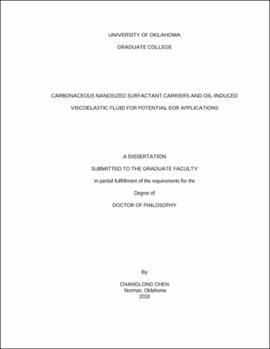| dc.description.abstract | This dissertation aims to advance the conventional tertiary oil recovery method, surfactant flooding process. Via injecting a finite slug of surfactant-only or mixture of surfactant/polymer solution into reservoir, surfactants are capable to dramatically reduce the residual oil/water interfacial tension (IFT) thus mobilize trapped oil. Despite the technical viability of surfactant flooding, this approach has some difficulties to be realized at large field scale, such as substantial adsorption loss, and unfavorable sweep efficiency of surfactant-only slug.
This dissertation examined the feasibility of using carbonaceous nanoparticles, multiwalled carbon nanotube (MWNT), and carbon black as potential surfactant carriers in enhanced oil recovery. Stability of MWNT dispersion at high temperature high salinity levels, typical encountered in reservoir, as well as transport and fate of these stable nano-fluids in porous medium were first examined as a prerequisite for any field applications. MWNTs exhibited exceptional stability in 10 wt% brine by dispersing them with nonionic surfactant such as alkylphenol polyethoxylates with a large number of ethylene oxide (EO) groups. In the sandpack column test, a binary surfactant formulation, which consisted of a nonionic surfactant and an anionic surfactant in the proper ratios, exhibited an excellent capability to propagate MWNT, with 96% of the injected nanotubes recovered in the effluent. Chapter 2 presents the details of MWNT stability and transport in porous medium, which was previously published on Energy & Fuels.
A successful surfactant delivery agent requires that surfactant ought to be released from the carriers once contact the target oil. In Chapter 3, batch adsorption tests indicated that competitive adsorption of surfactant on nanoparticles was beneficial to decrease adsorptive loss on Ottawa sand at equilibrium concentration below critical micelle concentration; microemulsions phase behavior proved spontaneous release of loaded surfactants from the treated MWNTs surfaces to oil/water interface; sand pack column tests carried out for an optimum surfactant formulation affirmed the advantage of adding nanoparticles into surfactant slug, as injection of MWNT-surfactant blend achieved faster and higher tertiary recovery than surfactant-only formulation. Chapter 3 was previously published on Fuel.
An episode in the research of stable carbonaceous nanoparticles dispersion, reversed binary micellar interactions between anionic surfactant alpha olefin sulfonate (AOS) and nonionic surfactant nonylphenol polyethylene glycol ether (NPEs) were observed depending on the addition of electrolytes. In the absence of additional electrolytes, NPEs exhibited substantially higher activity in micelles than bulk solution; with growth of EO groups, shrinkage on the scale of synergistic interaction was evidenced. In contrary, with swamping amount of electrolytes, synergistic interactions enlarged with the rise of EO groups, and AOS activity in mixed micelles was found depending on both EO length and bulk mole fraction 〖(α〗_A). These findings are summarized in Chapter 4 and have been published on Colloids and Surfaces A: Physicochemical and Engineering Aspects.
Chapter 5 discovered an oil-induced viscoelastic wormlike micellar solution. Wormlike micellar solution blends are important for industrial products where the high viscosity and elastic properties are exploited. However, wormlike surfactant micelles are extremely susceptible to oils; solubilization of paraffinic oils inside the micelle core leads to a disruption of wormlike micelles and loss of viscoelasticity. Oil-induced viscoelastic micellar fluid system is promising for various reservoir applications, such as proppant carrying fluids in hydraulic fracturing, and chemical slugs with built-in viscosity control in enhanced oil recovery.
Chapter 6 presents some concluding remarks of this work and recommendations for the future studies. | en_US |
